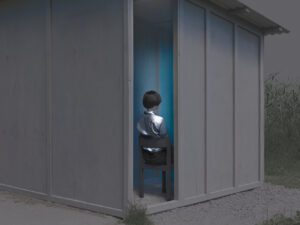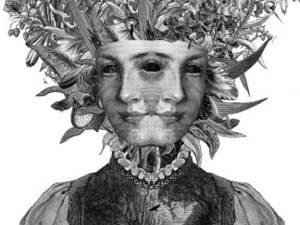Last year, the Peruvian government officially recognised “Pallequeras” – female mineral sorters who pick through stones discarded by their male peers on the slopes of mines. This huge movement enabled the women to participate for the first time in formal, regulated gold business transactions rather than relying on the black market. Such rife gender politics are just one aspect of Lisa Barnard’s The Canary and the Hammer, a photographic exploration of gold as a measure of the economy but also the greed and political power in the wake of the 2008 financial crisis. In an orotone of the Peruvian town of Filomena, perched in the coastal highlands, Barnard literally incorporates fair-trade gold leaf from mining company Sotrami in the print on Japanese mulberry washi paper. Her investigations also show how the precious metal has become an indispensable component of engineering and electronics, as well as a mechanical tool to tackle wider health and environmental problems.
Barnard joins seven other women photographers in a group show at Flowers Gallery, London, which explores tensions between genre and gender as they examine mankind’s role in a given area and the broader environment as a whole. Scarlett Hooft Graafland, who trained as a sculptor and launched her career as a performance artist, produces surreal scenes against the backdrop of desolate landscapes à la Gabriel Orozco but filled with subtleties and apparent contradictions. In fact, the Dutch artist often collaborates closely with locals for sculptural interventions and performances in places like Bolivia’s salt desert, the Canadian Arctic or the shores of Vanuatu. This practice yields images like burka-clad Yemeni women carrying long white balloons as they walk on the beach. “The people living in these remote places – who are so much closer to nature than most of us – are very helpful in creating the scenes with props that are available,” she has explained to Fotografiska, which has organised a major solo exhibition in the Stockholm venue (open until 8 September.)
Dafna Talmor’s Constructed Landscapes slice and splice colour negatives of unrelated surroundings to create photographs of an imaginary place in a pensive metaphor for the rootlessness of globalised identities. Space, time and memory collapse in the transient spaces. The manicured public and private green areas in Corinne Silva’s Garden State, meanwhile, reveal how the very act of gardening is a political one that shapes highly contested lands now home to 22 Israeli settlements. Here, the spreading fronds of a palm tree become a metaphor for territorial encroachment. Other works turn to abstraction, such as Mona Kuhn’s She Disappeared into Complete Silence where a single figure is set against a modernist glass and mirror structure by Joshua Tree National Park. At times refracted or fragmented, the resulting images are disorienting and hallucinatory.
Until 31 August. Find out more here.
Olivia Hampton
Lead image: Mona Kuhn, AD6883, 2014. © Mona Kuhn, Courtesy of Flowers Gallery.





